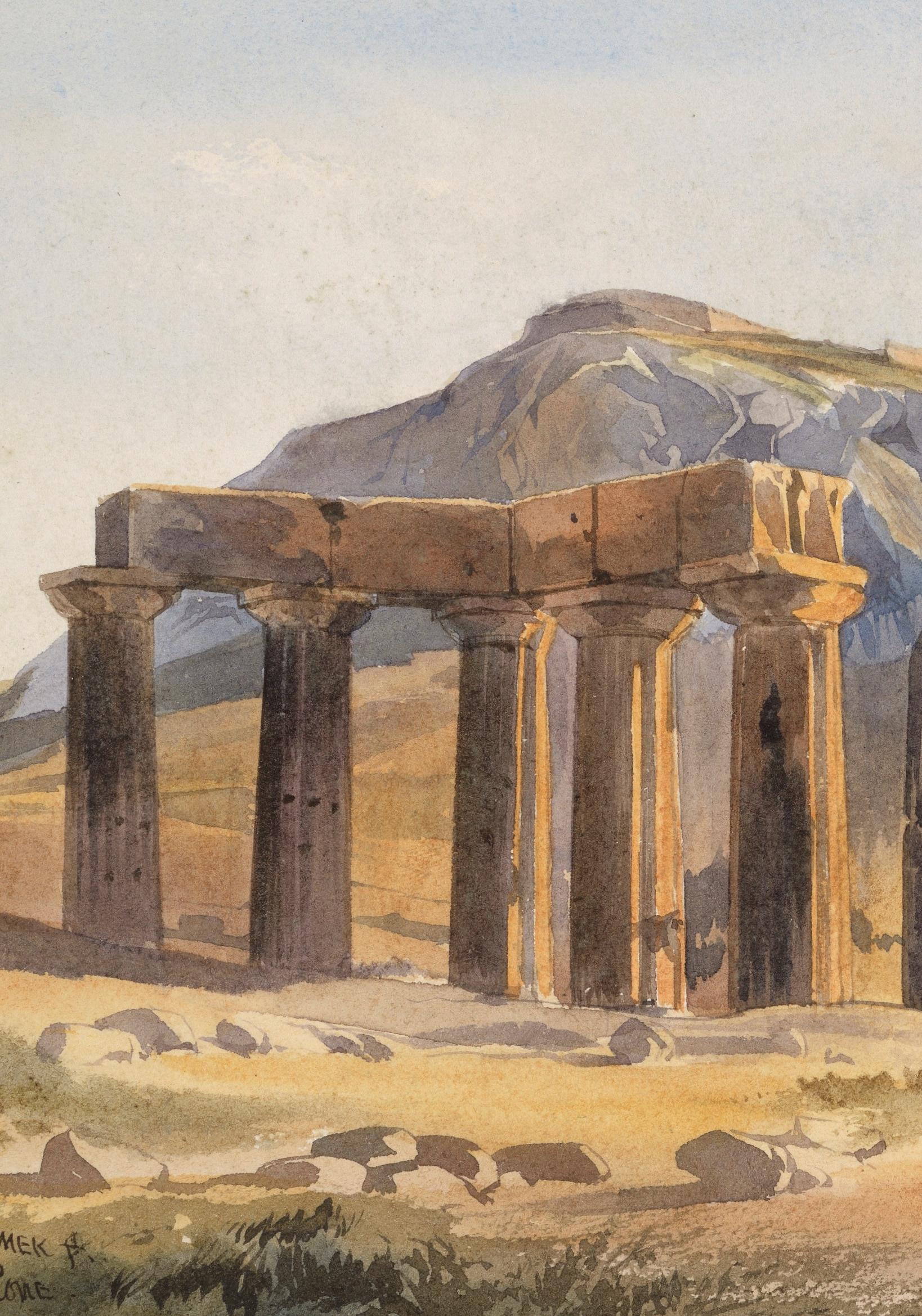
13 minute read
PART ONE
PART ONE Asia & Australasia
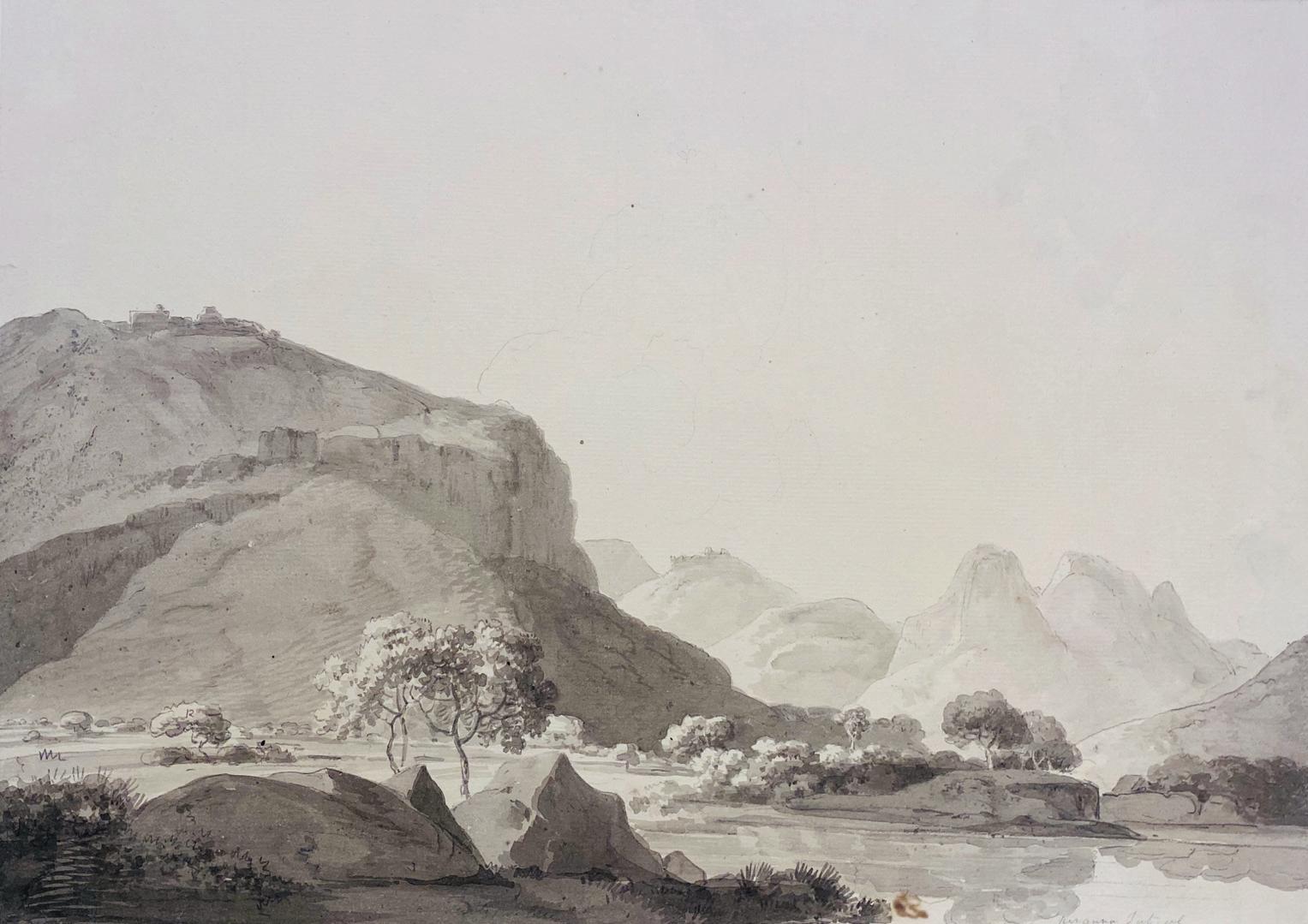
Advertisement
cat.1 Thomas Daniell RA (1749-1840) View in the Barramah’l Hills, south east of Bangalore, with distant hill forts
Dated May, 1792 Grey wash and pencil, laid on card 38 by 27cm Image inscribed ‘puranna Tatcul’ Later inscribed on card ‘Tatcool M….. (Tatikhal, eastern distr., Madras)’ later crossed out, ‘[May 1792]’, in the lower left corner numbered ‘147’. Provenance: Agnews, no.24529 Frame backboard with pounced Christie’s auction number
Thomas Daniell and his nephew, William, arrived in India in 1786. Their first artistic efforts were views of Calcutta followed by a tour north. In 1792, they headed south to Madras and then on to Sri Lanka, heading back to England in 1793 on news of the outbreak of war with the French.
The Daniells tour of south India, between March 1792 and April 1793, was through a land largely still to be explored by the British except in their efforts to contain Haida Ali and his son, Tipu Sultan. Moving through the hilly landscape south of Bangalore, the Daniells observed various hill forts from where Tipu Sultan’s soldiers continued to defend his empire. The distant hills in this painting also appear in another view by Thomas Daniell entitled ‘Jag Deo and Warrangur, Hill Forts in the Barramah’l’. Jag Deo and Warrangur were two of the twelve hill forts in the possession of Tipu Sultan. The present view has a near contemporary and closely related companion in the collection of the British Museum, entitled ‘Hills between Verapadrug and Cauverypatam’ and dated 11th May 1792.
Reserved
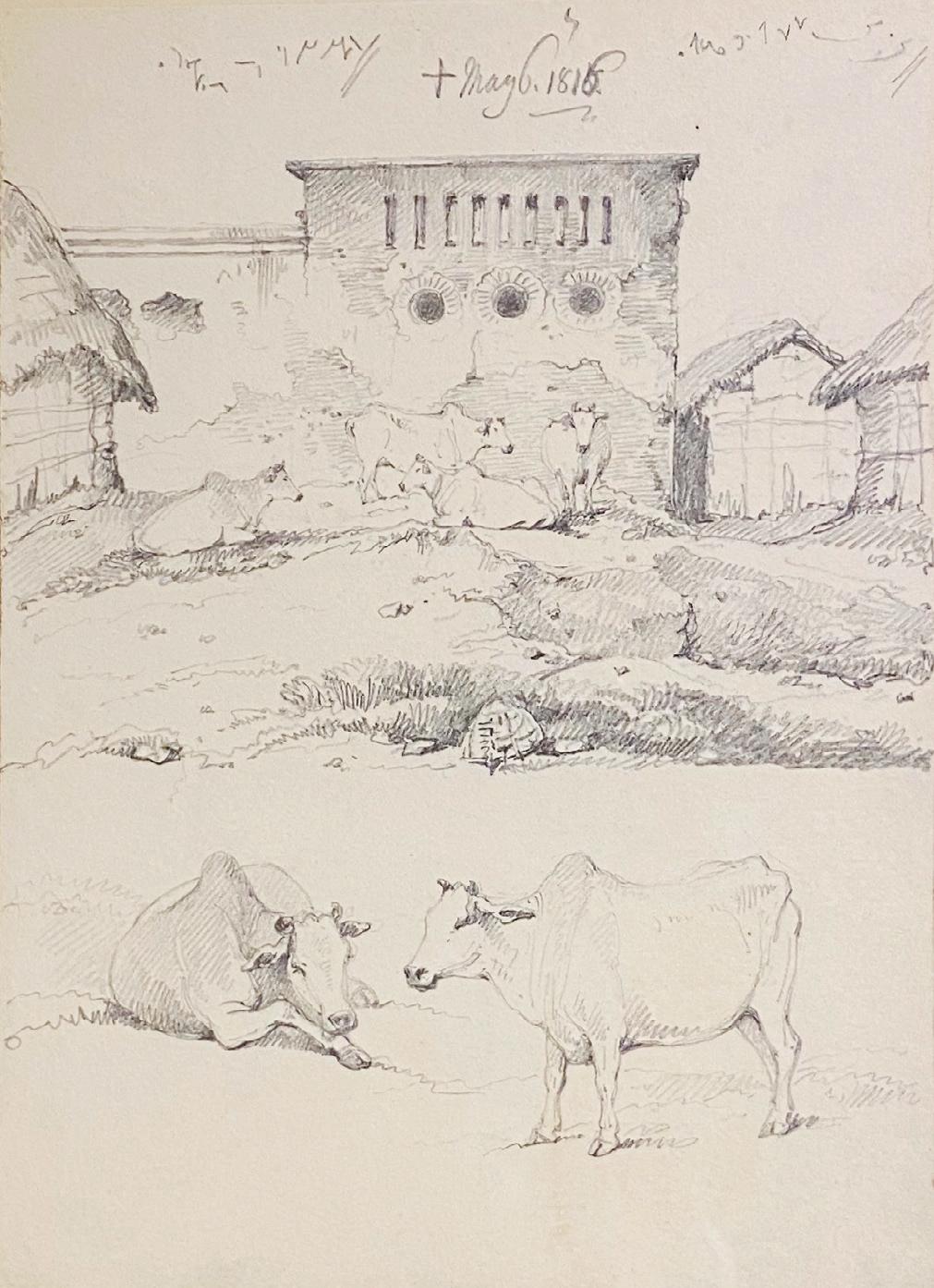
cat.2 George Chinnery (1774-1854) Scene in a Bengal Village
Dated 1816 Pencil on lined paper laid down on card, framed Provenance: Formerly with Spink and Son 23.8 by 17cm
Chinnery was one of the greatest of British artists to travel to India in search of better prospects. He was certainly the last of the truly important artists to settle in the sub-continent. His journey to India may also have been encouraged by an almost neurotic disposition for which society in India might prove a more forgiving refuge as it had proven to be for many Britons of less orthodox character.
As much as he relied on patronage from British society, Chinnery’s disposition would not allow him to endure its company without frequent escapes to the countryside. He took great delight in fleeing the strictures of portraiture and indulging in landscapes of bucolic villages on the outskirts of Calcutta and would happily have spent “the fag end of life in quietness and ease” which this escape provided him. This drawing is one that he made on such an occasion. The village, though not identified, appears in a number of his drawings and must have been a favoured place of refuge.
£1950
cat.3 Sir James Lillyman Caldwell (1770-1863) Temple at Ambarsumdrum, near Tirunelveli, Tamil Nadu
Dated June 1808 Inscribed ‘Ambarsumdrum, Tinivally..June 1808’ and initialled Grey wash and ink on laid paper 37.5 by 60cm
Sir James Lillyman Caldwell, General and Colonel Commandant of the Royal (late Madras) Engineers, lived a long life that combined a taste for military adventure and obvious danger with an equal enthusiasm for intellectual ingenuity and artistic expression.
He began his time in India in 1788 as a cadet of the East India Company gaining his first commission with the Madras Engineers in the following year. In 1791, he joined the forces lead by Cornwallis for the campaign against Tipu Sultan. Tipu’s forces were protected by a series of hill top forts across the region which were successively attacked by the British. Caldwell took part in many assaults in this campaign, both engineering the breaching of apparently impregnable defences and as a member of storming parties during which he suffered injury. At the start of the following year he took part in the Cornwallis night time attack on Tipu’s entrenched camp outside Seringapatam. This led to a protracted siege during which Caldwell was again wounded. A peace treaty with Tipu was agreed and Caldwell returned to Madras. For the next few years, his energies were spent on projects to improve public works until, in 1799, General Harris drew his forces together for another and final assault on Tipu Sultan. Caldwell led the ladder party in the successful assault in the second siege of Seringapatam, suffering injury twice including being shot at the top of the breach before falling into the ditch.
Upon recovery, he resumed his civil duties for a number of years but in 1810 adventure beckoned and he joined the British forces sailing to Mauritius to take on the French. Six months later he returned to his duties as a Chief Engineer in the Madras army and was charged with the duties of restoring the fortress at Seringapatam and subsequently the French settlements on the Malabar and Coromandel coasts. It was during this period that, with Major Thomas Fiott de Havilland, Caldwell designed the Cathedral Church of St. George in southern Chennai whose baroque design was inspired James Gibbs’ St. Martins-in-theField in London.
In 1837, he retired from the active list, receiving the K.C.B., and returned home to live at first in Paris and then, upon the death of his French wife, between London and the Isle of Wight, where he died in 1863.
He was noted for his skill as a watercolourist and his work as a surveyor of monuments afforded him both the time and opportunity to record the forts, palaces and temples of South India. A small number of his works are held in the collection of the British Library.
£2650
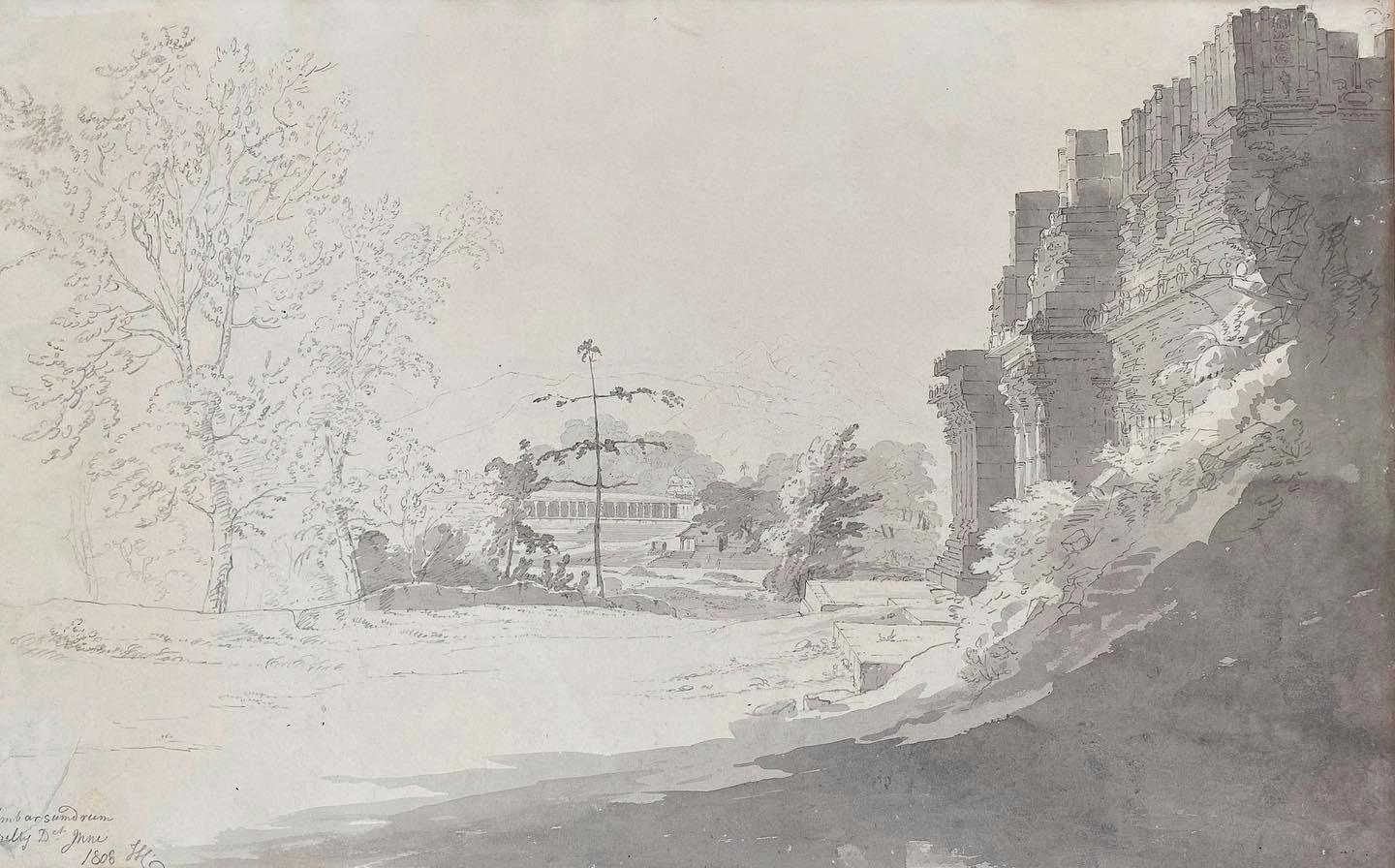
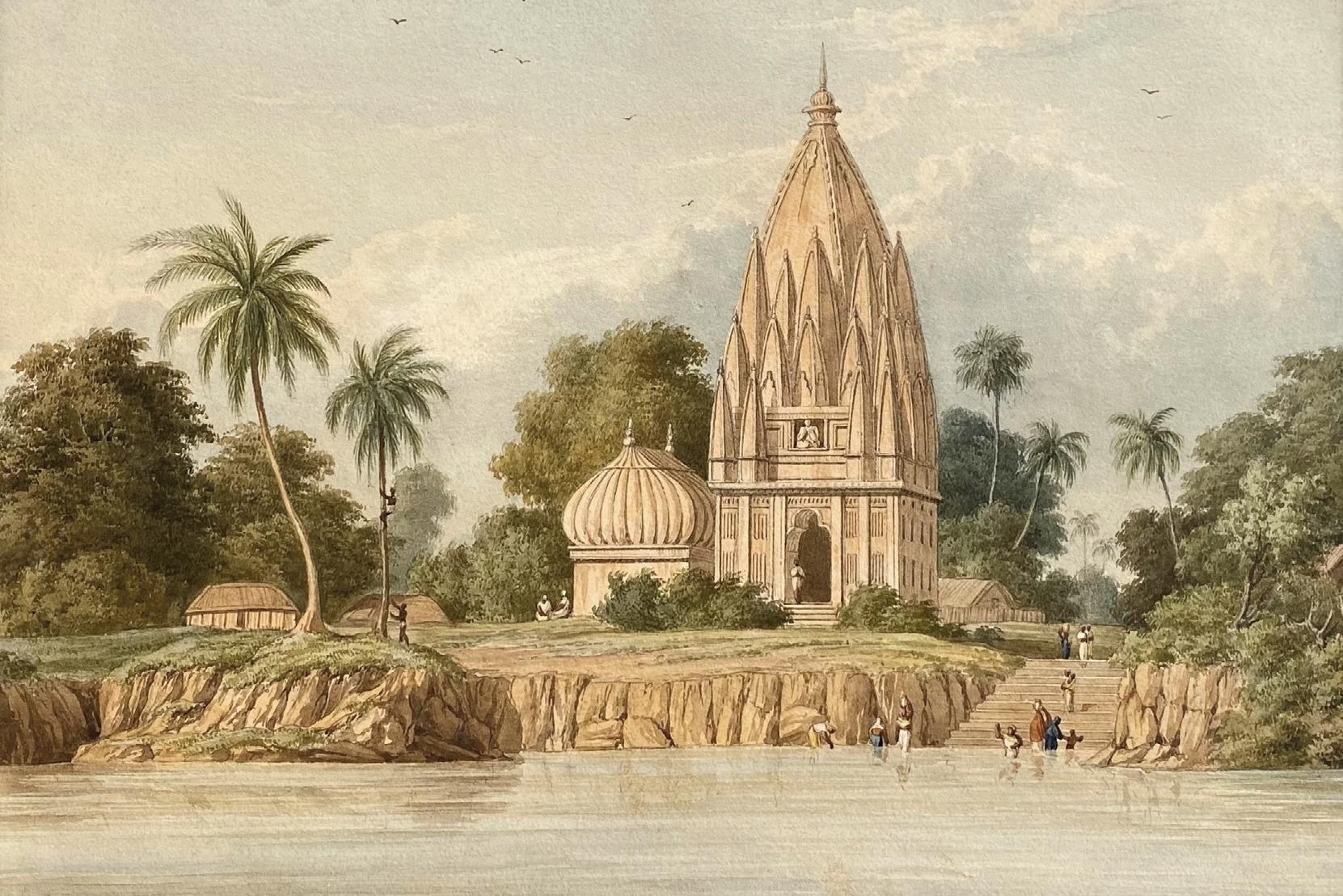
cat.4 Charles Ramus Forrest (1750-1827) Temple and village on the Ganges
Circa 1807/08 Watercolour and pencil on paper, framed 19.4 by 27.5cm
One of Charles Ramus Forrest’s beautiful watercolours of his travels up the Ganges and Jumna, the account of which he later published as ‘A Picturesque Tour Along the Rivers Ganges and Jumna’ (Ackerman, 1824, plate XI). The subject is a village and ‘pagoda’ which Forrest observed just below Patna near the town of Azimabad.
A soldier and amateur artist, Forrest recorded and illustrated his travels as an official of the East India Company copying the detail of the landscape attentively and often colouring them in situ in order to preserve the inspiration of the moment. Forrest gives an account of this precise moment in his published work. On 2 December 1807, he set out from Calcutta, passing through various towns along the river courses, including Bhagalpur, Monghyr and Patna. A few miles below Patna, he “passed a very prettily situated village, with its pagoda of a most picturesque form, its ghaut of the red stone, and its native Hindoos performing their ablutions in the sacred stream of the Ganges. The varied forms and tints of the foliage surrounding this romantic spot give a good relief and effect to the white buildings, as may be seen in the annexed view”.
£5500
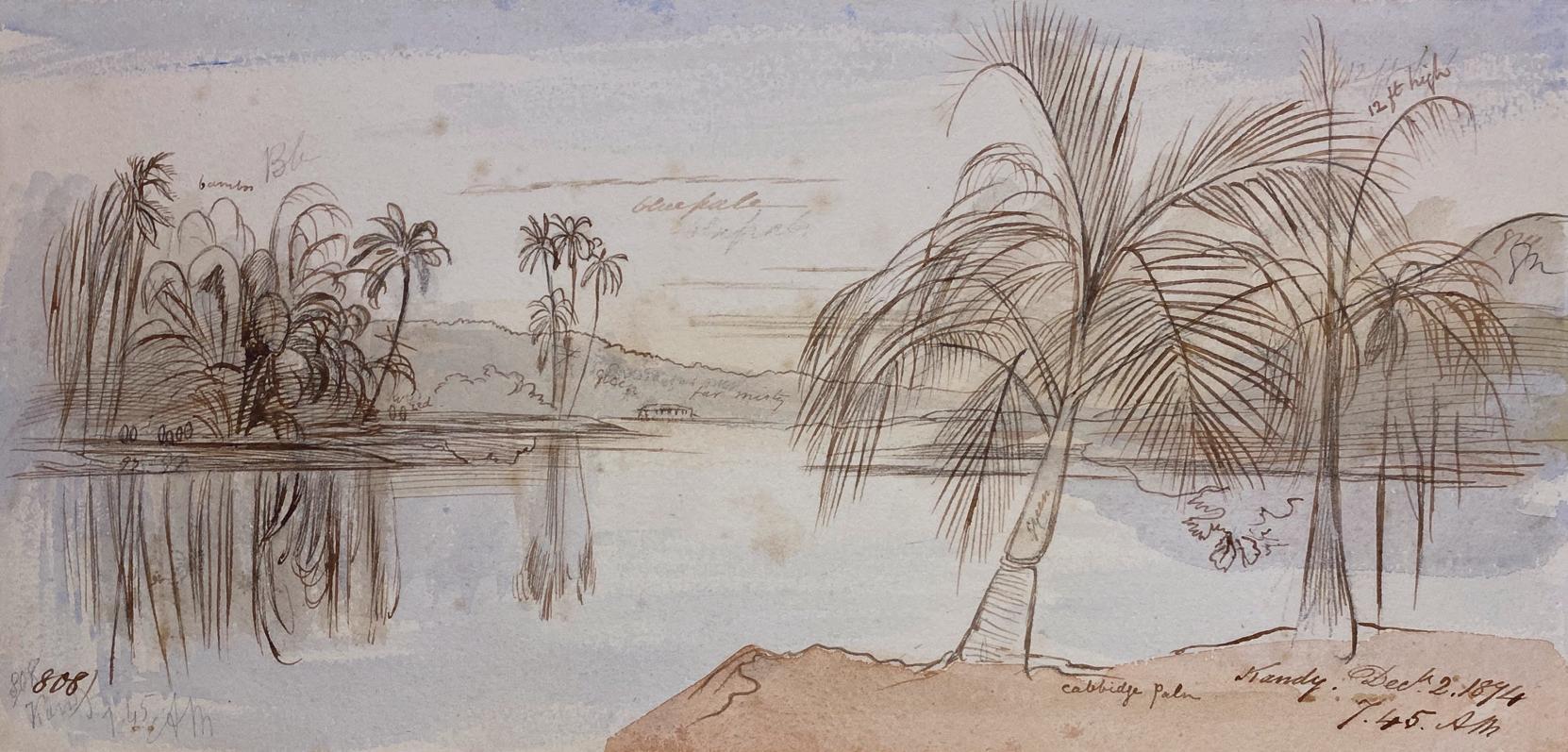
cat.5 Edward Lear (1812-1888) Kandy, Sri Lanka
Dated December 1874 Inscribed ‘Kandy, Dec. 2nd 1874, 7.45 a.m’ and variously with notes of subject, scale and colour Watercolour, pen and ink 16 by 34.5cm Provenance: Thomas Agnew and Sons
Lear arrived in India on 22nd November 1873 in a state of feverish excitement at the ‘myriad of impossible picturesqueness’ that lay before him to capture. He travelled widely in all directions arriving toward the end of his journey in the much anticipated Sri Lanka. But although Lear had long dreamt of the landscapes of this island, by the time he and his servant and companion, Giorgio, arrived in November 1874, both were tired from the exertions of the previous months and, in early December, Giorgio contracted dysentery. Consequently, their stay in Sri Lanka was brief, just a few weeks, and Lear’s depictions of the island are rare.
Lear took the train from Colombo to Kandy on 1st December which he found was a ‘singularly comfortable one’ taking two rooms at the Oriental on arrival. He found Kandy damp but delightfully quiet after the raucousness of Colombo. But his was the first day that Giorgio began to endure stomach pains –described by Lear in his diaries as ‘dolore do panza’ or indigestion – but which over the next two days was to be diagnosed as dysentery. He recorded drawing various views in the morning of the 2nd December before meeting with his friends, the Barings, at Government House. Lear himself was suffering from a bad sore throat and found his spirits slumping in the face off incessant rain. Advised to return to Colombo for the sake of Giorgio’s health, they returned to the coast on 7th December and, once a local doctor had advised that Giorgio was well enough to travel, they boarded the Asia headed for Tuticorin on 12th December.
After a brief time on the Malabar coast they headed to Bombay and within a month of their departure from Sri Lanka, Lear and Giorgio headed home.
£4750
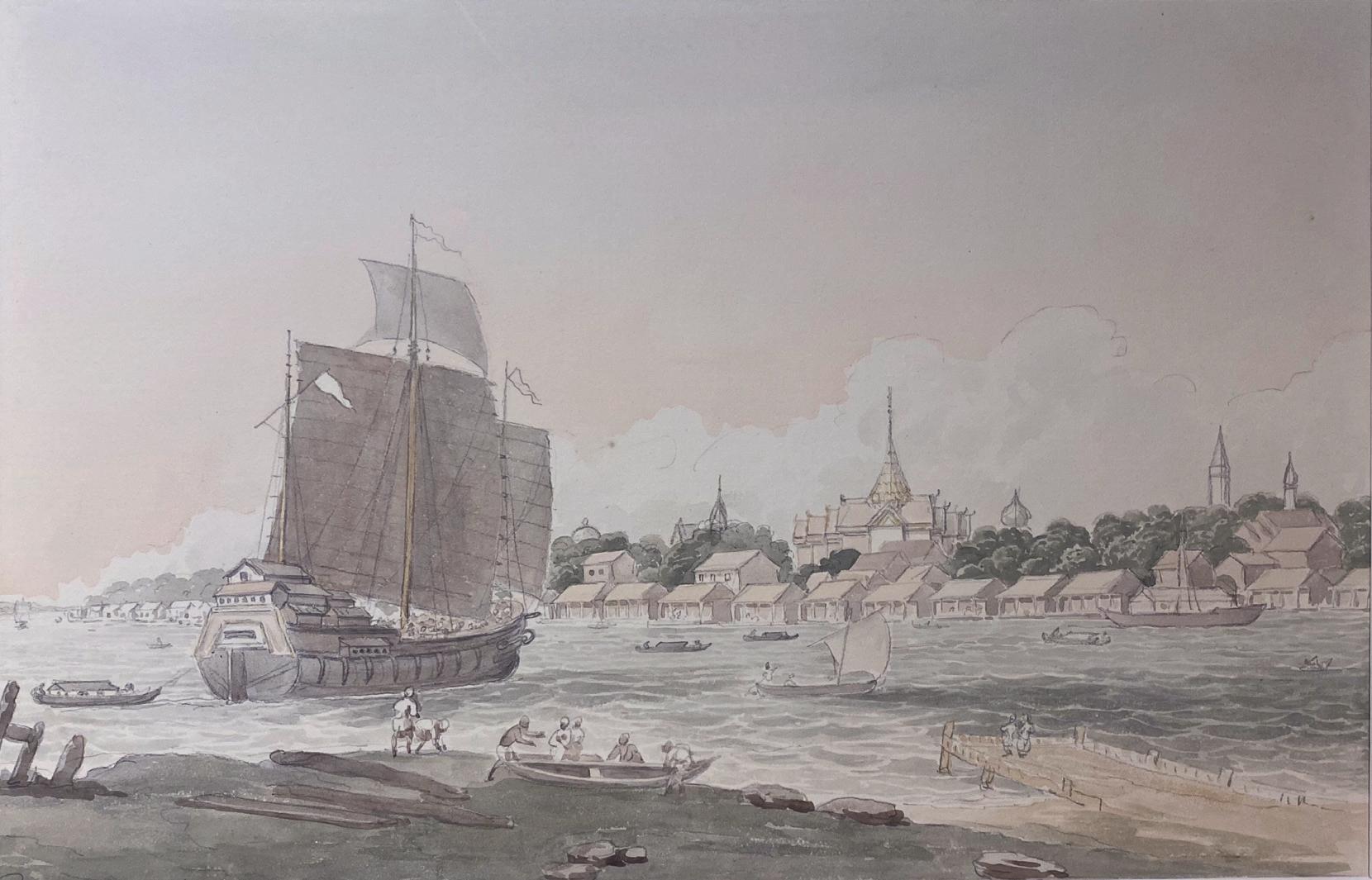
cat.6 Anon. An extremely rare early watercolour of a view of the city of Bangkok
Circa 1822 Watercolour on paper 29.2 by 19.2cm
This rare watercolour relates to a printed image used in a publication giving an account of the British mission to the court of Siam and Cochin China of 1822 undertaken by the then Governor-General of India, John Crawfurd. The account was taken from the journal of George Finlayson, the surgeon and naturalist to the mission and published in 1826 after Finlayson’s death.
The printed image was also used in Crawfurd’s own account of the mission, published in 1828, which sought to rebuff some of the Finlayson’s criticisms of Crawfurds approach to dealings with the Thai court. The mission had hoped to negotiate access to trade in Siam with the King but Crawfurd’s overly deferential manner with him was considered by Finlayson to have brought a lack of respect for the British officials from the Thai court. The French, in contrast, had already achieved access to trade with Siam, in the opinion of some, by their complete indifference to Thai court etiquette.
The temple buildings across the river have been tentatively identified as Wigan Yot, built by King Rama III, and part of Wat Phra Haew, the temple of the emerald Buddha.
The printed version gives as artist of the original drawing the initials ‘H.A.C.’ but this artist has yet to be identified in full, though presumably a member of the 1822 mission.
£1850
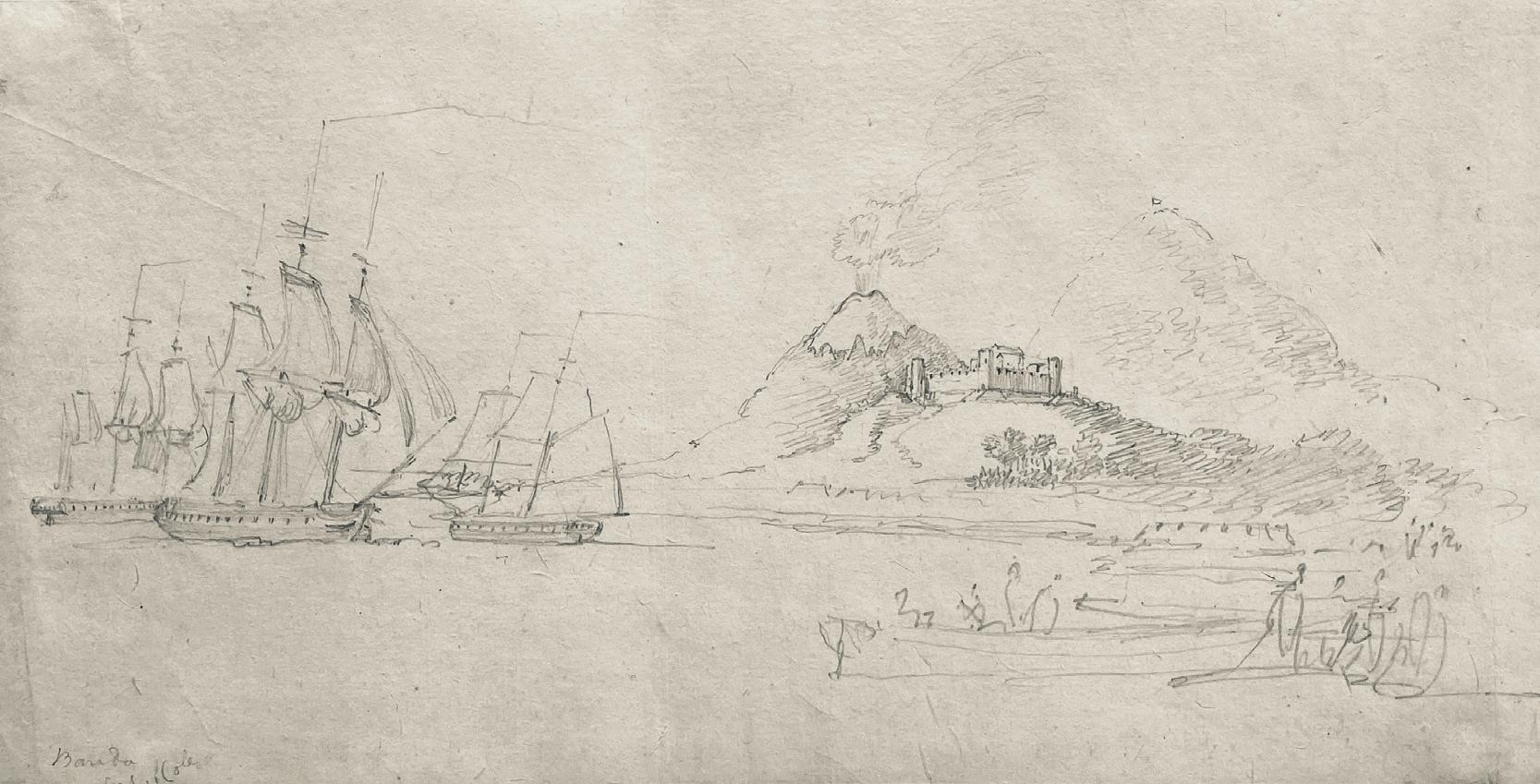
cat.7 Captain Sir Christopher Cole (1770-1836) The Capture of the Fort of Banda Neira
Circa 1810 Pencil on paper in two sections, a further sketch on the reverse Inscribed lower left ‘Banda….Cole’
Cole fought in the American Revolutionary War, the French Revolutionary wars and the Napoleonic wars but is perhaps best known for his exploits in the Dutch East Indies in 1810-11, where he was instrumental in the capture of Amboyna and Java.
On 9th August 1810, Cole led and attack on the heavily fortified island of Banda Neira. He had four ships, including the Caroline, under his command. Although the operation started badly for him, Cole personally led a small band of men into the fortress and forced the Dutch into surrender. This drawing depicts the small boats taking this landing force to the fort. Cole made a number of sketches of the actions on the day of the attack, perhaps in preparation for the engagement. This drawing is an extremely rare survivor of that group which are otherwise known only from the prints which were derived by artists such as William Daniell from Cole’s original sketches (see British Museum 1917,1208.4597 and 1871,1111. 662).
£975

cat.8 Anon. The Sacking of the Taku Forts
Circa 1860 Watercolour on paper 28.6 by 20.6cm
Known as the third battle of the Taku Forts in the second Opium War, in 1860 a joint force of British and French troops made another attempt to take the Chinese position only a year after suffering defeat. This earlier attempt was followed by a year of reconnaissance which allowed the European forces to focus the attack on the weakest point in the Chinese fortifications and, bolstered by British troops fresh from suppressing the uprising in India, victory was swift. This was one of the last major engagement in the Second Opium war for it gave the European forces clear river access to Peking. Before the end of the year success at the Battle of Palikao resulted in the European forces occupation of the capital.
£1450
William Swainson (1789-1855) Four Views in New Zealand
1841-55
William Swainson was a renowned English ornithologist, malacologist, conchologist, entomologist and artist. He published and illustrated numerous publications on the subject of natural history and was elected a fellow of the Royal Society in 1820, on his return from an expedition to Brazil. His reputation in Britain was tarnished following his support for the Quinarian system of biological classification, a system proposed by William Sharp Macleay in 1819 but which, despite the support of proponents such as Swainson, quickly fell out of favour. As a result, in 1841 Swainson decided to retire from scholarly work and emigrate with most of his family to New Zealand. He bought a plot of land in the Hutt valleys south of Wellington. But his life-long love of natural history remained unabated and in his sketches in and around his estate it is clear that the sight of a fine natural history specimen, often tree ferns, inspired a beautiful and accurate depiction of the scene. Following disputes over land ownership with local Maoris, Swainson left for Sydney in 1851 and embarked on further natural history studies before returning to New Zealand a couple of years later where he died in the Hutt Valley in 1855.
Many related examples of Swainson’s sketches from this period and earlier, along with much of his correspondence, are in the National Library of New Zealand.

cat.9 William Swainson (1789-1855) A View of the Soft Leaved Fern and Hutt Forest, New Zealand
Pencil on paper, mounted 15.5 by 12.3cm Inscribed on mount ‘The Soft leaved Tree Fern & Hutt Forest (Cyathia Mollis [sic])’
The paper is a section of a page from a natural history publication with a section of printed text on the reverse. The original mount card watermarked ‘E & P 1805’ referring to Edmeads and Pine. The inscription on the mount is in the artist’s own hand. His attribution of genus and spelling is mistaken. In modern classifications, the tree depicted is a form of Cyathea, possibly medullaris.
£875

cat.10 William Swainson (1789-1855) McDonoughs Creek, Lower Hutt, New Zealand
Pencil on paper, laid on card, mounted 16.8 by 10.4cm
Inscribed on image lower right ‘WS 1841-8’ and partial inscription lower left. Inscribed on card below image ‘McDonoughs Creek, Lower Hutt, NZ’ and on reverse in the artist’s hand ‘Since this drawing was made a substantial wooden Bridge has been erected’. The drawing depicts a figure crossing over a shallow gorge on a felled tree trunk. As often with Swainson’s drawings, his interest in the natural history content demonstrates itself with his careful and accurate depiction of the leaves of the tree fern in the background.
£800
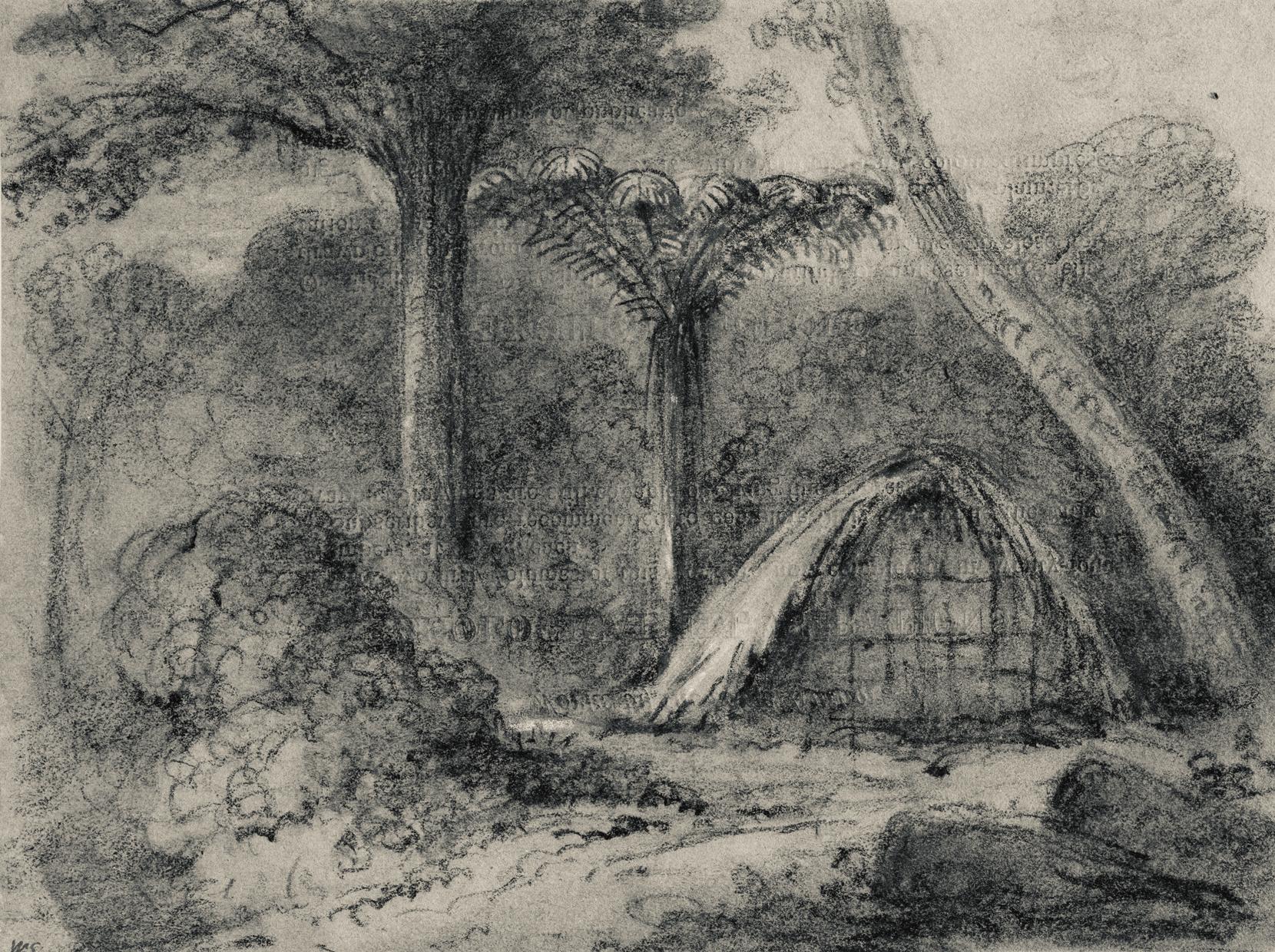
cat.11 William Swainson (1789-1855) A Native Hut on the Hutt Road, New Zealand
Pencil heightened with white on paper, the paper printed with text on the reverse, laid on card, mounted 11.9 by 16cm Inscribed on image lower left ‘WS.’; on card below image ‘Native Hutt [sic], near the Gorge, Hutt Road’
£750
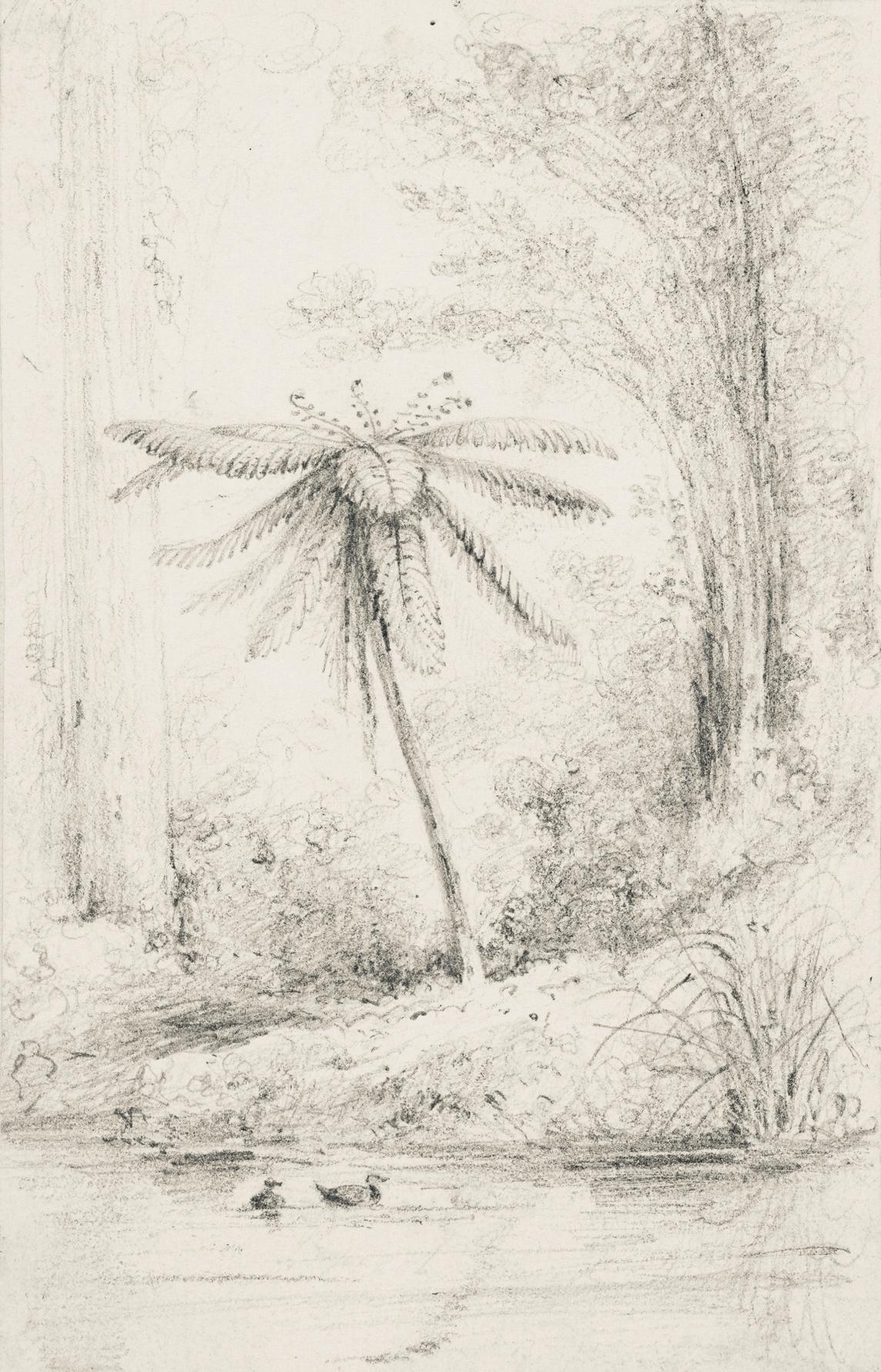
cat.12 William Swainson (1789-1855) A Black Tree Fern, River Hutt
Pencil on paper, laid on card, mounted 17.5 by 11cm Inscribed on the card below the image ‘Black Tree Fern, River Hutt’
£800
